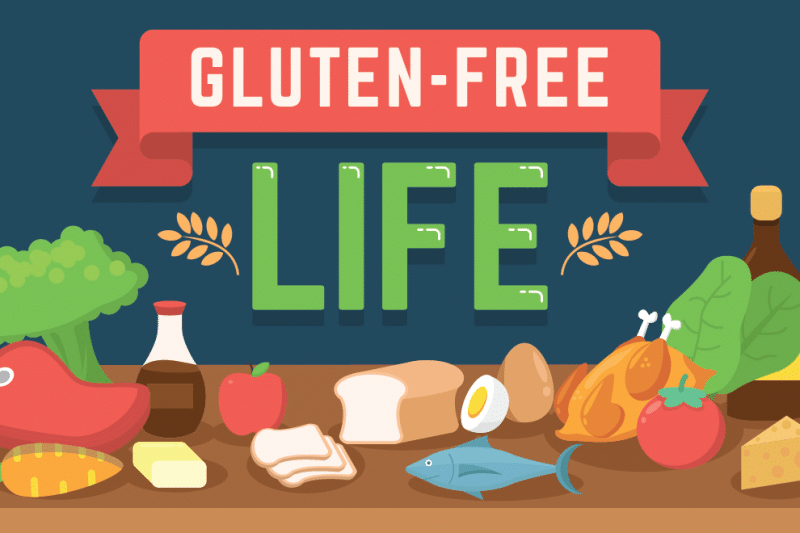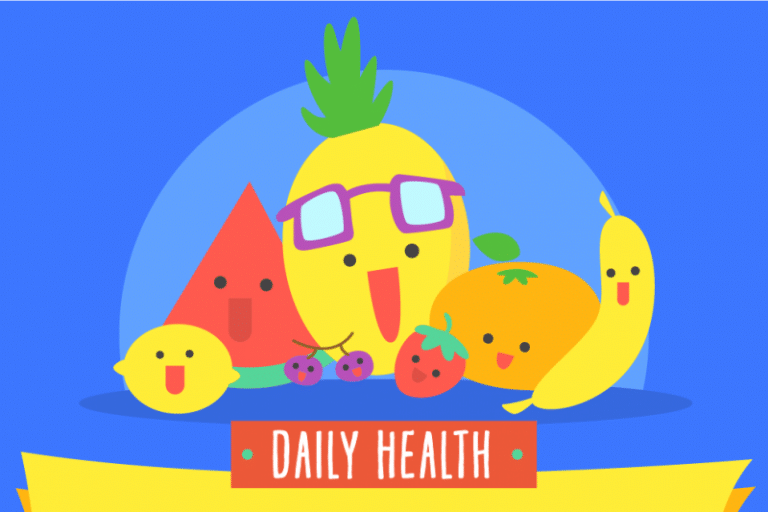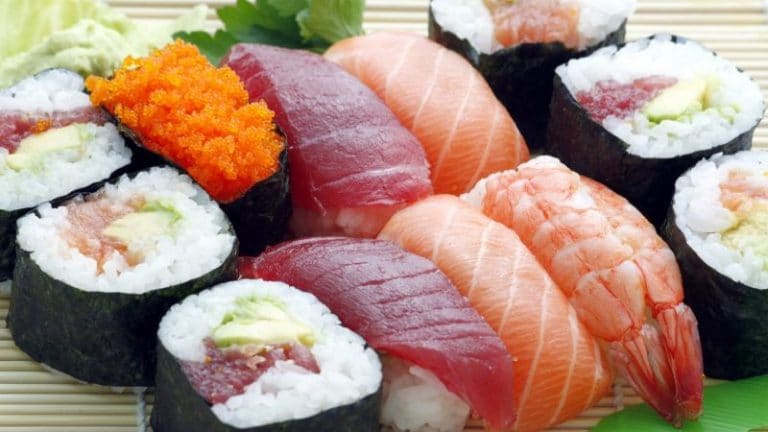Gluten-Free Life (Infographic)

Gluten has gotten a lot of bad press over the last few years. It’s said to cause inflammation, digestive ailments, and a whole lot more besides. There are countless stories about gluten-free diet benefits from those who have cut it out completely.
But is it actually as bad as many suggest? Let’s examine this issue a lot more carefully and see what the absolute truth is. After all, it can be difficult to avoid gluten, so this kind of diet may not be all that simple for us.
What Is Gluten?
To put it very simply, gluten is a protein found in certain grains. You’ll find gluten in wheat, barley, triticale, and oats. Oats are primarily gluten-free but we’ll put them in this group because they often get contaminated with gluten from other grains.
What is gluten made of? Glutenin and gliadin are the two main proteins that make up gluten and are known as plant storage proteins. Plant storage proteins are found in the endosperm of cereals and perform an essential role in storing the nutrients they need to grow.
These proteins also help gluten food to keep its shape. That’s why it’s so essential in baked goods—it helps bind the ingredients together and form a nice elastic dough. In fact, gluten usually makes up 75%–85% of all the protein content in wheat flour.
It’s what gives bread that nice chewy texture and is also responsible for the bread being able to rise as it traps gas during kneading and the rising process. That’s why gluten–free bread tends to be less light and fluffy and why it doesn’t rise quite as much during baking.
Gluten is vital in baking. There are substitutes, but you’ll never get quite the same results. That said, you don’t have to give up bread completely; you just need to change the ingredients that you use.
What Foods Do You Avoid on a Gluten-Free Diet?
The usual suspects are wheat, rye, barley, triticale, and oats and any products made using these grains. So, look out for gluten in the following:
- bread
- baked goods
- soups
- pasta
- cereals
- sauces
- salad dressing
- malted barley
- malted shakes
- malt extracts
- malt flavorings
- malt vinegar
- malt syrup
- beer
- brewer’s yeast
- some food coloring
Uses of Gluten Outside of the Food Industry
On an interesting side note, gluten is also an excellent binding agent, and so it may be found in some of your favorite beauty products. So, if you want to use only gluten–free products, check the list of ingredients in shampoos and lipsticks as well.
According to a study published in 2018, the quantities of wheat gluten in these products would not trigger a hypersensitive reaction or cause you to become more sensitive to it as long as the peptides in it are restricted to a particular atomic weight.
That means that products containing excessive amounts of gluten could potentially cause issues in those with gluten intolerance signs. The general verdict then would be that it’s probably safer to avoid beauty products that contain gluten.
This may seem like a step too far, but it might be necessary for those battling celiac disease to take note of. We know that you’re not going to munch down on a tube of lipstick anytime soon, but small amounts are ingested every time you wear it, so it’s better to be on the safe side with this one.
The Zuzu Luxe range from Gabriel Cosmetics and the Eco Bella range are two companies that ensure that their makeup has no gluten. Similar companies include Boscia, Juice Beauty, and Aubrey Organics.
How Do You Know If You Are Gluten Intolerant?
Tests can be performed to diagnose full-blown celiac disease, but it’s more challenging to diagnose gluten intolerance. According to Medical News Today, the surest gluten allergy test is to cut gluten foods entirely and see if your symptoms improve.
Celiac disease is the most severe disease and requires that you cut gluten out completely or risk damaging your digestive system. It is also relatively rare and will affect around 1% of the population.
As for gluten intolerance vs. celiac disease, after ingesting gluten, two people may experience the same symptoms—bloating, stomach discomfort, and diarrhea—but they may have two separate gastrointestinal (GI) diseases: celiac disease and gluten intolerance. Gluten intolerance is a sensitivity to gluten, whereas celiac disease is an autoimmune illness.
It might surprise you to learn that gluten sensitivity is not quite as common as you might think. It affects up to around 6%–7% of the US population, though the numbers can vary significantly. This is also quite difficult to diagnose because the symptoms may come hours after eating a meal.
That’s why an elimination diet is maybe the best test for gluten intolerance. Once the symptoms have abated, you can gradually start adding foods with gluten in them back in and see if the symptoms return. The symptoms can be similar to that of wheat sensitivity, so that can also muddy the waters.
Gluten Intolerance Symptoms
Digestive Tract Symptoms
- Bloating is one of the most common symptoms and is present in 87% of cases.
- 83% of gluten intolerant people will experience abdominal pain and discomfort.
- Diarrhea affects around half of all gluten intolerant people as well. It is also one of the symptoms of gluten intolerance in children.
- Constipation is another potential symptom in about a quarter of all cases.
- Unexplained weight loss occurs in about 25% of all cases.
Neurological Symptoms
- Headaches might be another symptom and occur in just over half of all cases.
- 38% of sufferers say that they experience “brain fog.”
- Arms and legs may feel numb. This could be a result of celiac disease affecting the neurological system.
- Depression could also indicate a gluten allergy, though it’s only present in 18% of all cases.
- Anxiety occurs in 39% of cases.
General Symptoms
- About 31% of sufferers will experience joint and muscle pain or fibromyalgia that improves on a gluten–free diet plan.
- Iron-deficient anemia is a symptom often linked to sensitivity.
- Fatigue is an indicator and occurs in 64% of cases.
- Around 29% of sufferers develop a gluten intolerance skin rash.
As you can see, the symptoms are very varied and can easily be attributed to other factors. That’s why it can be so difficult to pin down the actual causes. Each symptom on its own is no cause for concern. However, if you have a few of them, it might be time to consider getting tested for gluten sensitivity. That’s easy, as there are at-home tests.
Why Is Gluten Bad for You?
If you have celiac disease, this can be a significant issue and potentially life-threatening. Sensitivity can present with many of the same symptoms and, while it won’t kill you, it could make you feel miserable.
The gluten itself is not unhealthy. The problem is that some people’s bodies can’t handle processing it. In gluten intolerant individuals, it is treated like an antigen, and the immune system responds accordingly, but it also attacks its own cells. This autoimmune reaction leads to chronic inflammation and several associated health issues. It can take as long as three years to recover completely from a disease related to gluten.
What Does Gluten Do to the Body?
Nothing much if your body can process it. It is only where you are sensitive or have celiac disease that you’ll have real issues. As mentioned before, it can cause an autoimmune response, and that, in turn, can lead to dangerous levels of inflammation that damage the gastrointestinal wall.
It can also cause digestive upsets as the body tries to rid itself of the antigens. Expect gas, diarrhea, and abdominal cramps as a result.
Is a Gluten–Free Diet Good for Everyone?
If you eliminate gluten from your diet, you’ll need to be sure that you’re still getting enough fiber and that you eat a healthy and nutritious diet. Naturally, you consider eliminating gluten if you feel that gluten intolerance is something you are experiencing.
If you’re older than 65, be sure to get enough fiber. Constipation in the elderly can be exacerbated by not getting enough dietary fiber and also by stress. Following a healthy diet when you’re over 65 is especially important.
Since the reaction to gluten can damage your gastrointestinal wall, your ability to absorb nutrients might be affected, so you can become deficient in vitamins, particularly the following:
- vitamin D
- vitamin B12
- folate
Minerals you may want to supplement:
- iron
- magnesium
- zinc
- calcium
Perhaps you’re still wondering what the gluten-free benefits are and whether or not it’s worth making the sacrifice. We’ll go over the benefits properly in the next section, but the sacrifice is not as bad as you might think. So there are both gluten-free diet benefits and risks.
You also need to ensure that you source your food from reputable suppliers as the food might be contaminated. And there is hidden gluten in foods, too. Overall, though, as long as you stick to more natural, whole foods, you should be okay.
Could we benefit from a gluten–free diet? Around 25% of Americans follow this diet. At the same time, gluten–free statistics show 13% of Americans believe that cutting out gluten is unhealthy. So, it seems that not everyone is convinced about the benefits of this lifestyle choice.
Gluten-Free Diet Benefits
For those who have sensitivity, there are some benefits to this kind of diet. These include:
- fewer digestive upsets and easier digestion
- extra energy
- weight loss
- helps improve the absorption of nutrients
- a great way to overcome those brain fog symptoms
Even if you haven’t been diagnosed with a gluten-related medical issue, a gluten-free diet is popular. So, there are benefits of a gluten-free diet for non-celiacs, too. The diet claims to boost health, weight loss, and energy, but additional research is needed.
Gluten Foods to Avoid
The following foods should be cut out altogether:
- barley
- beer
- tortillas made with wheat flour
- graham crackers
- ramen noodles
- bran
- breaded foods
- udon
- matzah
- oats
- pasta is also one of the gluten intolerance foods to avoid
- bulgar wheat
- durum
- couscous
- wheat flour
- wheat
- farina
- malt
- semolina
- farro
- kamut
- spelt
- bouillon cubes
- pizza
That answers your question: “What can you not eat on a gluten diet?” Interestingly enough, many people make the mistake that wheat-free and gluten-free are the same thing. They aren’t, so check wheat-free foods to see what they’ve replaced the wheat with.
What Can Gluten-Free People Eat?
Now, to the question that all newbies are dying to have answered. Although there are many foods with gluten in them, you might be surprised to learn that there are a lot of foods that you can eat. The difference being, mostly, that more refined and processed foods are going to be excluded. Check out the list of foods you can eat below and tell me you’re still going to feel deprived once you get used to eating this way.
List of naturally gluten–free foods:
- eggs
- beans, peas, and legumes
- corn
- rice
- fish
- meat
- fruits
- butter
- flax
- buckwheat
- sorghum
- cheese
- millet
- tamari
- potato
- chicken
- nuts
- seeds
- seafood
- oils
- vegetables
- soy
As you can see, there is still a lot of food that you can eat. Need a few more options? Then check out our list of gluten–free grains and substitute products:
- amaranth
- brown rice
- white rice
- buckwheat
- almond meal
- coconut flour
- corn
- cornstarch
- guar gum
- millet
- pea flour
- potato flour
- potatoes
- quinoa
- sorghum
- soy flour
- teff
As you can see from our list of gluten–free foods and snacks, it’s easy enough to find substitutes for gluten without resorting to a bunch of expensive replacement foods. You can opt for this option without having to spend an absolute fortune.
Celebs and Gluten–Free Statistics
Contrary to popular belief, this kind of diet dates back to the 1940s. It is only over the last few years that it’s had such an upsurge in popularity, though. Currently, about a quarter of those aged 18–24 try to eat gluten–free foods.
As a society, we are embracing this style of eating more and more. Before 2009, you’d only find foods containing gluten listed on a restaurant menu. Between 2009 and 2012, the number of menu listings for gluten-free foods increased by 275%.
Sales in this area almost doubled between 2011 and 2016, and the market has shown year-on-year growth since then. So, if you’re wondering, “Should I go gluten-free?” now would be a good time. The market is well-established.
Kim Kardashian and Lady Gaga are two examples of celebs who avoid food with gluten and follow this diet out of choice. Zoe Deschanel is a celebrity with full-blown celiac disease. She has to follow this kind of eating plan. There are a good few other celebs who also follow the diet for health reasons.
Novak Djokovic became the world’s number one tennis player soon after discovering his gluten sensitivity. These celebrities and sports stars swear by gluten-free meals and credit the diet to transform their health and well-being.
About 59% of women now agree that paying more for gluten-free options is worth it. Also, starting a gluten-free diet for weight loss is a popular option for those wanting to lose weight. Almost a third of those following the diet do so because they want to drop a little weight.
From a health perspective, the incidences of celiac disease are on the rise. In the States alone, 1 in 100 people has it. I’ll bet that the gluten–free pasta option is looking pretty good right now, isn’t it? You never know—you might have celiac disease and not realize it yet.
The incidence of non-celiac gluten sensitivity is a lot higher—about six to ten times higher. It’s estimated that up to about 6% of people might have this form of gluten sensitivity. The stats could be higher than we realize. Science has linked 55 diseases to the proteins found in gluten.
Is It Easy to Find Gluten-Free Snacks?
It is rather, and you don’t have to make a special trip to the health-food store—most grocery stores will now carry these products. We advise you to check the gluten-free food list that you can eat above carefully. A lot of manufacturers mark their foods as having no gluten to get a premium price. The catch is that they may do this with foods that don’t naturally have gluten in them.
If you’re in the United States, you’ll find following this diet is a lot easier. There are a lot of gluten-free options on offer in the States. Sales of these products, along with the free-form food market, were projected to be worth 23.9 billion there by 2020.
If you have one of the following stores in your area, you’re bound to find some of the best gluten–free foods:
- Walmart
- The Kroger Company
- Shop-rite
- Whole foods
- Sainsbury
- Hannaford
- Trader Joe’s
- Super Valu
- Target
- Ahold Delhaize
- and don’t forget, you can also order online from Amazon
Be sure to keep a lookout for gluten–free pizza. It’s surprisingly tasty. So, as you can see, you have gluten-free fast food options, too. As to the importance of stocking glutenless snacks? About 51% of people surveyed said they would be more likely to buy these products if the stores had dedicated aisles for them.
What About Eating Out?
There are many ways to find restaurants that prepare meals according to gluten–free recipes, such as:
- Celiac Travel’s free restaurant cards in over 50 languages.
- The Gluten-Free Restaurant Card app offers its online version of the cards in 40 languages.
- Allergy Translation allows you to customize your cards and offers 43 language variants.
- Triumph Dining will enable you to buy laminated restaurant cards in 10 languages.
How Can I Eat Foods That Are Gluten-Free While Traveling?
It might take a bit more forward-planning on your part, but there are plenty of options for travelers as well. You could:
- Find a local app to help you find restaurants that serve these meals.
- You could also look online to find the right places to eat or get food from.
- Be careful with the snacks you pack for the journey—just check whether or not any customs restrictions apply.
- Order the specialized meal from the airline.
- Pack herbal teas to drink.
- Download printable restaurant cards in 54 languages for free from Celiac Disease.
- Alternatively, load the Gluten-Free Restaurant Card app on your phone to help you out overseas.
- Do some research into gluten–free desserts so that you can always be assured of something sweet when you need it.
The Best Gluten-Free Brands
- Breyer’s
- Udi’s
- Complete Start
- Aldi
- BFree
- Ener-G
- Happy Campers
- Barbaras
- Barilla
- Cocoa Libre
Some Great Products to Try Out
- Rudi’s Gluten-Free Multigrains
- RXBAR Peanut Chocolate Bar
- Caulipower Margherita Pizza
- Primizie Ancient Grains Crispbreads
- Dr. McDougall’s Organic Superfood Mega Omega Oatmeal
- Pure Organic Vanilla Almond Ancient Grains Bar
- Saffron Road Beef Bulgogi with Brown Rice
- You can also find lots of gluten–free beer options out there
Final Notes
From a pure health perspective, cutting back on gluten could benefit everyone if it means cutting some of the highly processed foods out of their diets. Hopefully, this post has helped you answer the question, “Why is gluten bad for some people?”
This may not be the simplest diet to follow at first. You have to start checking food labels carefully and giving up foods like bread and pasta can be tricky. If you keep the gluten-free diet benefits firmly in mind, though, and persevere through the first month or so, it becomes a whole lot easier.
FAQs
Is rice gluten-free?
Rice is gluten-free in all of its natural forms, whether white, brown, or wild. Natural rice is an excellent alternative for people who are gluten-intolerant or allergic to gluten, a protein present in wheat, barley, and rye, as well as those who have celiac disease, an autoimmune illness caused by gluten.
What does removing gluten from your diet do?
Your body goes through several changes when you remove gluten from your diet. In fact, there are gluten-free diet pros and cons. Let’s start with the pros:
- better digestive health
- promotes good cholesterol and reduces bad
- prevents unhealthy eating
- helps with epilepsy, autism, and schizophrenia
Some of the cons are:
- lack of fiber
- type 2 diabetes possibility
- lack of vitamins
Does a gluten-free diet help lose belly fat?
Many people start a gluten-free diet to lose weight. However, there’s no evidence of a link between a gluten-free diet and weight loss. However, if you follow a gluten-free diet, you may choose healthier food choices. When you eat gluten-free frequently, you might eat more foods, including fruits, vegetables, legumes, and lean meats. These dietary modifications are typically healthier and lower in calories.
What are the negative effects of a gluten-free diet?
Here are some of the dangers people face when they transition to a gluten-free diet without a medical reason: lack of fiber, lack of vitamins and nutrients, type 2 diabetes possibility, and weight gain. So, those are the negative aspects that cover your question: “What happens to your body when you stop eating gluten?”
For celiac disease patients, a gluten-free diet is crucial. However, if you simply don’t eat gluten, it could be harmful to your health. Instead, concentrate on making gluten-free choices that are better for you. For instance, instead of white bread, eat whole wheat bread (high in fiber).
How long does it take to detox from gluten?
Within a few weeks of starting a gluten-free diet, your symptoms should improve. In just a few days, many patients begin to feel better and feel the gluten-free diet benefits. However, it will most likely take several months for your intestines to return to normal. And it may take years for them to recover fully.







